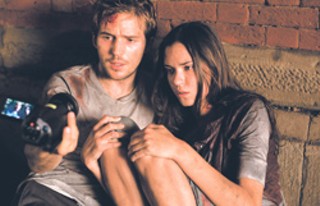Cloverfield ***
It’s almost impossible not to describe this terror tale as “Godzilla meets The Blair Witch Project,” as it exclusively relies on the camcorder wielded by one of its characters to capture the rampage of a frightening behemoth (and its even more terrifying sidekicks, vicious arachnoid creatures) as it destroys Manhattan with single-minded determination. Past films that employed this trick often seemed silly -- what sane person wouldn’t drop the camera in the face of real danger? -- yet in our modern-day, techno-crazed world, the need to capture everything on film (as if to validate its authenticity, not to mention provide the shooter with a fleeting 15 minutes of fame) is such a built-in instinct for many people that the actions of the protagonists in this film rarely come into question. Director Matt Reeves and writer Drew Goddard also effectively tap into post-9/11 anxieties: It’s hard to witness collapsing skyscrapers and the resultant deadly debris hurtling down New York City streets and not be reminded of that fateful day. While some might consider such a tactic to be in extremely poor taste, there’s no denying its potency when viewed through fictional horror-film lens -- for all its newfangled innovations, the movie shares DNA with similarly themed sci-fi yarns from the 1950s. And like many fantasy flicks, this one also contains a defining “money shot” (a la the exploding White House in Independence Day); in this case, it’s the decapitated head of the Statue of Liberty, forlornly resting on a city street. Heads roll in Cloverfield, and none more startlingly than this one.
How She Move **1/2
A thoughtful, heartfelt drama that can’t quite get past the conventions of its plot mechanics, How She Move is the latest dance flick in which motion trumps emotion. That’s not to say there isn’t a certain amount of poignancy in the central plotline of a young teen hoping to break free of her dire surroundings -- it’s just that this picture only truly comes alive when its talented young cast is strutting its stuff in rhythm to the music. How She Move focuses on African-American teenager Raya (Rutina Wesley), a student at a private school who’s forced to move back to her impoverished neighborhood after her parents spend all the family funds trying (and failing) to save Raya’s drug-addicted sister. Deemed stuck-up by Michelle (Tre Armstrong), a sullen classmate with a perpetual chip on her shoulder, Raya tries to keep her head down and solely concentrate on her studies, but she ends up getting drawn back into the world of stepping, a high-energy form of dancing practiced by both Michelle and Bishop (Dwain Murphy), a charismatic guy who hesitantly allows Raya to join his dance team just in time for the annual Step Monster competition. The screenplay by Annmarie Morais saddles the characters with too many scenes revolving around tired dialogue, but director Ian Iqbal Rashid compensates by staging the vigorous dance scenes as if his life -- or at least his career -- depended on it.
There Will Be Blood ***
I’m not sure Daniel Day-Lewis’ performance in There Will Be Blood represents the best acting of 2007 (as various critics’ groups have declared), but it certainly represents the most acting of the past year. His performance here as Daniel Plainview, a prospector who strikes it rich in turn-of-the-century California, basically comes across as Bill the Butcher (his character in Martin Scorsese’s Gangs of New York) turned up a couple of notches. Then again, Day-Lewis’ oversized turn is right in line with Paul Thomas Anderson’s oversized ambitions in creating a modern-day masterpiece, a movie so audacious that it flagrantly apes Citizen Kane during its final half-hour and recalls The Treasure of the Sierra Madre at regular intervals. That so many critics are indeed calling this an instant classic isn’t surprising, but if the No Country for Old Men vs. There Will Be Blood grudge match continues to gain traction, I’m afraid I’ll have to pledge my allegiance to the Coen Brothers’ equally brutal, equally risky but ultimately more satisfying drama. Anderson’s latest film isn’t even up to the standards of what I consider his real masterpiece, Boogie Nights, though there’s enough here to please hardcore cineasts as well as more adventurous moviegoers. Based on Upton Sinclair’s novel Oil! the movie opens with a superb 12-minute sequence with no dialogue -- perhaps a nod to Erich Von Stroheim’s silent milestone, Greed, also about the destructive power of accumulated wealth? During this sequence, we’re introduced to Plainview, a determined prospector who over time strikes it rich and becomes one of the nation’s most powerful oilmen. Plainview has an adopted son in young H.W. (Dillon Freasier), who ends up going deaf after sitting next to an oil rig that explodes as it brings up black riches from beneath the surface. Plainview tries to be an acceptable parent to the boy, but he’s hardly a social creature, intolerant of those around him and not one to extend trust or affection easily. His greatest adversary as he tries to milk the land dry is Eli Sunday, an unctuous preacher who’s as much the conniving showman as Daniel Plainview. The picture is a beauty to behold (Oscar nods for technical achievements should breed like rabbits), and there are individual sequences so staggering that a second viewing will hardly be a chore. But those planning to check it out should be sure to bring an umbrella, Rocky Horror Picture Show-style, just in case Day-Lewis’ juicy lip-smacking manages to break through that fourth wall.
The Savages ***
How interesting that 2007 produced two pictures about Alzheimer’s that approached the subject from diametrically opposite points. (It’s also interesting that these two movies, both involving caregivers, were written and directed by women, usually deemed the primary caregivers in our society.) Sarah Polley’s Away From Her was about a man who dearly loved his wife and was devastated as the disease created an unbreachable gap between them. Tamara Jenkins’ The Savages (finally reaching town) is about siblings who dislike their dad and are upset that circumstances dictate they be responsible for his well-being. Away From Her was a straightforward drama, but The Savages is a black comedy that frequently goes down like the most bitter coffee imaginable. Philip Bosco plays the father figure around which the action stirs: Found smearing his own excrement on the bathroom walls of his Arizona residence, he’s eventually placed into the hands of his distant -- both geographically and emotionally -- offspring, Jon and Wendy Savage (Philip Seymour Hoffman and Laura Linney). Jon’s a college professor in Buffalo, while Wendy’s an aspiring writer in New York City; neither one has the time nor the inclination to take care of the old man -- more so since by all accounts he made their childhoods miserable -- but they do their best to find him suitable lodging in an “assisted living” facility. But Wendy’s definition of suitable is different than Jon’s, and the siblings end up squabbling about his living arrangements, a discussion that opens up a can of worms regarding their relationships not only with their father but with each other. Overall, The Savages is a keenly observed study offering believably bruised people making the best out of their rickety lives. As for the two leads, they’re equally superb. Linney turns every one of Wendy’s foibles and insecurities into a mountain that the character must scale before she can come to acceptance with herself, and the actress keeps us firmly in her corner. As for Hoffman, this is his third great performance of 2007 -- he’s also aces in Before the Devil Knows You’re Dead and Charlie Wilson’s War -- and thanks to a smashing sequence in which he describes the brutal realities of growing old, it’s also his best.
Mad Money **1/2
Around this time last year, moviegoers were suffering through Because I Said So, a Diane Keaton vehicle so horrific that it barely got beat out by License to Wed for the top spot on my year-end 10 Worst list. Luckily, Keaton’s new film Mad Money is much better, simply by virtue of the fact that I wasn’t tempted to cram a gun muzzle into my mouth this time around. That’s not to say it couldn’t have been better. Callie Khouri won a well-deserved Oscar for penning Thelma & Louise, and it would have been interesting to see what additional shadings she could have lent to the situations on display here. But for Mad Money, she only serves as director, leaving the writing assignment in the hands of Glenn Gers. The Anthony Hopkins-Ryan Gosling thriller Fracture (which Gers wrote) was a pleasant surprise last year, and Gers fares best in this latest picture when he focuses on the intricacies of the heist that our leading ladies intend to pull off. But I’m getting ahead of myself. Keaton stars as Bridget Cardigan, an upper-middle-class wife reeling from that fact that her husband Don (Ted Danson, very good in his best role in ages) has lost his job and they may now be in danger of losing their home and comfortable lifestyle. As a temporary solution, Bridget takes a job as a cleaning lady at the Federal Reserve Bank, where she eventually devises an elaborate scheme to steal the worn-out bills marked for destruction in the building’s shredding facilities. She enlists the aid of two co-workers, sensible single mom Nina (Queen Latifah) and vivacious party girl Jackie (Katie Holmes), and the trio set about pulling off the most unlikely of heists. Mad Money is a generally entertaining picture, even as it dabbles in implausibilities and often fails to get a firm grasp on its characters (for example, several scenes attempt to paint Holmes’ Jackie as an utter dingbat when she clearly isn’t).


























